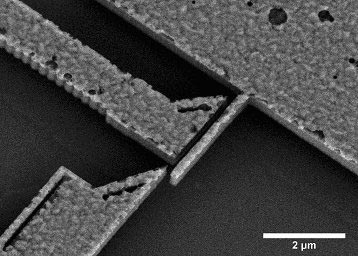
Researchers in the US are the first to make tiny electromechanical logic circuits that operate at temperatures as high as 500 °C. The circuits contain two switches made from silicon carbide and operate as a logical NOT gate. The team believes that its nanoelectromechanical system (NEMS) could be used in microcontrollers embedded in hot machinery such as jet engines or oil-drilling rigs.
Modern technology is increasingly reliant on embedded computer control systems, but some equipment is simply far too hot for conventional silicon electronics to function. The problem is that normal computer chips do not work above about 300 °C because heat causes transistor junctions to degrade – and also because thermally excited electrons alter the electronic properties of the semiconductor.
Designers have got round this problem by making high-temperature microcontrollers from silicon carbide (SiC), which is much more resistant to heat damage than plain silicon. In addition, the amount of energy needed to thermally excite an electron is much greater in SiC. Unfortunately, transistors made from SiC tend to be large, slow and power hungry and only work at high voltages.
Switching cantilever
Now, Mehran Mehregany and colleagues at Case Western Reserve University in Cleveland, Ohio, have shown that superior high-temperature microcontrollers can be made from tiny mechanical switches just a few hundred nanometres in size.
To build its device, the team coated a silicon wafer with a thin layer of silicon oxide and then a 400 nm thick layer of SiC. The researchers then used electron beam lithography to make a simple switch comprising two SiC electrodes (the gate and drain) that are spanned by a SiC cantilever beam (the source). The SiC switch was released from the wafer by using a chemical to etch away the silicon oxide.
When a voltage was applied between the gate and source, the electrostatic force was found to pull the beam into contact with the drain (but not the gate). This allows current to flow between source and drain, making the device a NEMS field-effect transistor. Mehregany and colleagues were then able to make a NOT logic gate by combining two such switches.
The team operated the device at 500 °C at a frequency of 500 kHz and with logical input voltages of ±6 V. While this voltage is much higher than silicon logic devices – which work at 3 V or less – the NEMS logic of ±6 V is in line with other high-temperature devices, according to the team. And because the switching voltage is not an intrinsic property of the device – as it is in a semiconductor – the device’s voltage could in principle be further reduced by making the component switches smaller.
No lower limit
The team was able to operate a typical switch for about 21 billion cycles at room temperature before the cantilever beam fractured. At 500 °C, however, the switches only lasted about 2 billion cycles. The team also found that at this temperature, there was a tiny ball of SiC at one end of the fracture. This is puzzling because SiC normally sublimates at 1800 °C.
Case physicist Te-Hao Lee told physicsworld.com that the ball fracture could be caused by a temperature-related electrical spike that occurred during the switching operation. “By refining the design of the switch, it is possible to reduce the bending stress on the switch and as a result, improve the switch reliability and lifetime significantly,” he says.
Gigahertz operation
Lee believes that these and other improvements could result in devices that could deliver a trillion cycles of reliable operation at gigahertz speeds – which would exceed the speed and lifetime requirements of a typical microcontroller circuit.
In addition to boosting the performance of individual switches, the team is working on integrating the devices into more complex circuit elements such as an adder or register. It is also looking at the problem of how to package the devices for high-temperature applications.
The work is reported in Science 329 1316.



